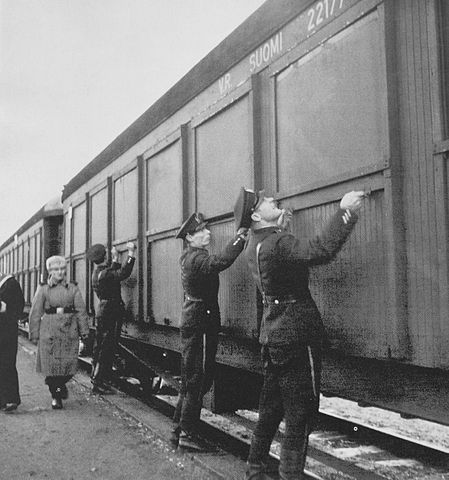
A Finnish Air Force submarine search patrol over Porkkala archipelago during the Continuation War. Photo: SA-kuva.
According to the Moscow Armistance signed in 1944 Finland was enforced to lease the Porkkala peninsula and its archipelago for the Soviet purposes. The pact included a Soviet exclusive rental right at Porkkala for 50 years during 1944-1994. In 1944 the local population at Porkkala were given 10 days for the evacuation, until the 29th of September when the area would be occupied by the Soviet Union. Porkkala-treaty was ratified during the Paris Peace Treaties 1947 and Porkkala replaced the earlier Soviet Hanko Naval Base which Finland had ceded after the Winter War. In 1955 an agreement was reached between Finland and the Soviet Union and Porkkala was returned to Finland in 1956. Having a propaganda value, the Soviet Union used the event as an example about its peaceful intentions with foreign neighbors.
During the Soviet era some 30 000 of Soviet soldiers were stationed at Porkkala. The Soviet 55th Rifle Division was converted into the 1st Mozyr Red Banner Naval Infantry Division of the Baltic Fleet and formed a garrison at Porkkala Naval Base. The garrison included also one Soviet tank regiment and two Soviet airbases were built for MiG-15 jet aircraft. Porkkala was proclaimed as a Soviet military area, all kind of civil staying and living was forbidden and access to the area was denied. The Soviet attitude towards the trespasser varied - sometimes they were just thrown out, but sometimes intruders were sent to the Gulag-system. The Porkkala-treaty included also a Soviet transit right through the Finnish soil for supply and the rental- and transit right as a whole raised concerns, the Finnish President noting, - It's not suitable according to the rules and norms set by the international law.

The Soviet Union allowed a Finnish railway transit right through Porkkala peninsula in 1947, however under heavy control and surveillance.
"Porkkalan Tunneli" - "Porkkala Tunnel" described and narrated the Finnish railway transit right through the Soviet area between Kauklahti-Tähtelä railway stations. Steel plates were inserted onto every window in the passenger cars to prevent people from seeing to the military area and a Soviet-made locomotive was set to pull the train. Soviet soldiers got on board the train to monitor the order in the train cars. This rare opportunity to experience the living set by the Iron Curtain attracted especially American tourists.

Soldiers of the Finnish Army (and probably two former locals in the middle) crossing the barbed wire border zone in January 1956 when Porkkala was returned for Finland. The soldiers are equipped with bolt-cutters and a Finnish flag.
From its founding, the Porkkala Naval Base and military area, it had been expensive to maintain and difficult to supply in the Soviet view. While approaching the last years of the occupation, Soviet exposure, discipline problems and inactivity appeared. The Soviet Union started preparing abandoning the base already in early 1955 practicing scorched-earth-tactics. The Soviet officials arranged a tour for the Finnish- and foreign media in the area and civil population were granted with a permission to return to their homes after 12 years. The restoration also aroused conversation and rumors about the Soviet Union returning all the Finnish lost territories, but it didn't come to a realization. The Porkkala restoration had a deep and significant impact for the Finnish policies and mentality. In the western world, the Soviet concession was experienced as a propaganda trick while it held strict order among the European people democracies.
- 3

